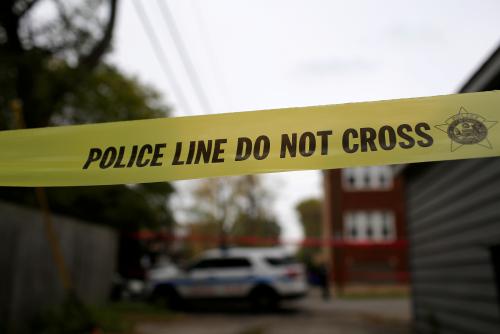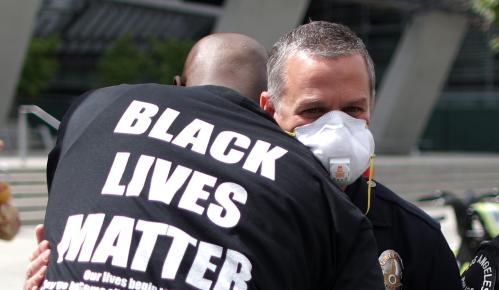Police departments across the United States are facing a crisis of confidence. Bystanders have recorded on cell phone video a large number of incidents where officers appear to unjustifiably harm or kill civilians, sparking outrage across the country and making us wonder what additional abuses our cameras have missed. Communities are no longer willing to take police officers’ word for it that force was necessary in violent incidents, and this lack of trust makes it difficult for police to do their jobs. In response, citizens and legislators have called for all officers to use body-worn cameras (BWCs) so that all interactions with civilians are recorded. Many people are hopeful that this technology will facilitate cultural reform, increasing officer accountability and reducing abuses of power. Unfortunately, the evidence so far is mixed.
BWC advocates hope that the cameras will have a civilizing effect on all involved: officers and civilians alike should behave better when they know their behavior is being recorded, reducing the number of violent interactions between officers and civilians. In cases where officers do use force, the video footage will offer factual evidence about what occurred, so that abusive officers can be quickly disciplined, fired, or even convicted of crimes, preventing them from further abusive use of force. If BWCs have either of these effects, use of force by police should fall.
Those officers may become more likely to use force when they know camera footage will demonstrate the facts were on their side.
However, it’s also possible that BWCs could increase use of force: Perhaps most officers show restraint in heated situations to avoid being accused of bad behavior. You might think this implausible, given how rare it is for police officers to face disciplinary action. But facing an accusation can be quite unpleasant, even if it does not lead to penalties, and even a small chance of losing your job or going to prison might be enough to make at least some police officers wary of using force in a borderline situation. Those officers may become more likely to use force when they know camera footage will demonstrate the facts were on their side.
Since the effect of BWCs could be positive or negative, we need to rigorously test the effects to know how people respond to this tool.
Over the past several years, many police departments have implemented BWCs in randomized controlled trials (RCTs), randomizing when officers are supposed to wear a camera and when they’re not. Most studies randomized by shift, so that everyone on duty at particular times wears a camera, and at other times everyone doesn’t. In a new study in Washington, DC, the police department randomized BWCs by officer, so that some officers always wore a camera, while other officers never did. There are pros and cons to each of these randomization strategies, mostly involving the types of spillover effects we might expect across shifts or individual officers. But both strategies allow us to compare the behavior of those who are wearing BWCs with the behavior of a control group that isn’t wearing BWCs.
Previous RCTs in American and European police departments found that BWCs reduced the number of complaints filed by local residents against the police. However, they showed mixed effects on use of force by and against police officers. In some places, BWCs increased force, and in others they decreased force. The context surely matters – how severe is the local problem, how motivated are officers to change their behavior, and how much accountability do the cameras provide? Local policies about when officers are required to turn their cameras on, and when footage is released, likely have an impact on the value of BWC programs. Figuring out whether changing these policies can increase BWC effectiveness is a crucial next step in this research area.
The behavior of officers who wore cameras all the time was indistinguishable from the behavior of those who never wore cameras.
The DC study was the first in a major U.S. city, and so will be of particular interest to other large cities rolling out BWC programs. The study was conducted by the Lab @ DC, a research group in the Mayor’s Office, in collaboration with the Metropolitan Police Department (MPD). (Full disclosure: I am a Senior Social Scientist with the Lab, though I certainly do not speak for that office and I am not an author of the BWC study.) This study found no significant impact on use of force by officers, or citizen complaints against officers: that is, the behavior of officers who wore cameras all the time was indistinguishable from the behavior of those who never wore cameras. The authors looked at myriad other outcomes and found that BWCs had no significant effect on any of them.
It’s possible that BWCs affected community trust in ways that don’t show up in DC’s police data: if individuals feel safer and trust the police more, that’s a good thing, even if actual use of force isn’t changing. And it could be worthwhile to have footage in rare events where a problem officer needs to be held accountable. But it’s tough to argue from the DC data that BWCs affected day-to-day police behavior in any way.
This could be because the MPD had already made other meaningful changes to its training and accountability systems, and so the types of behavioral changes BWCs might induce have already happened. The MPD was under DOJ investigation between 1999 and 2001, and committed to implementing a variety of policies aimed at reducing use of force. Perhaps those policies already reduced forced as much as it could be reduced. It’s also possible that cameras are so ubiquitous in the District (due to the widespread use of cell phone cameras and CCTV cameras) that officers already assumed they were being recorded at all times. In any case, the marginal value of BWCs in the District seems to be zero.
You might think that as long as the BWCs aren’t doing any harm, it makes sense to keep using them. But BWC programs are extremely costly, mostly due to the costs of storing and managing the video footage. DC spent $1 million dollars on cameras, and will spend an additional $2 million each year for data storage going forward. Given this new evidence that BWCs have no impact on police behavior in the District, DC might be better off spending its taxpayers’ dollars in other ways. If the MPD chooses to keep BWCs, it should be clear about what goals it is trying to achieve in doing so, and why the Lab’s RCT could not measure those effects. It’s possible that BWCs will have bigger impacts on police behavior in other cities. But places considering implementing BWCs should follow DC’s lead and rigorously evaluate their programs, to be sure they’re getting the progress they hoped for.







Commentary
Do body-worn cameras improve police behavior?
October 25, 2017